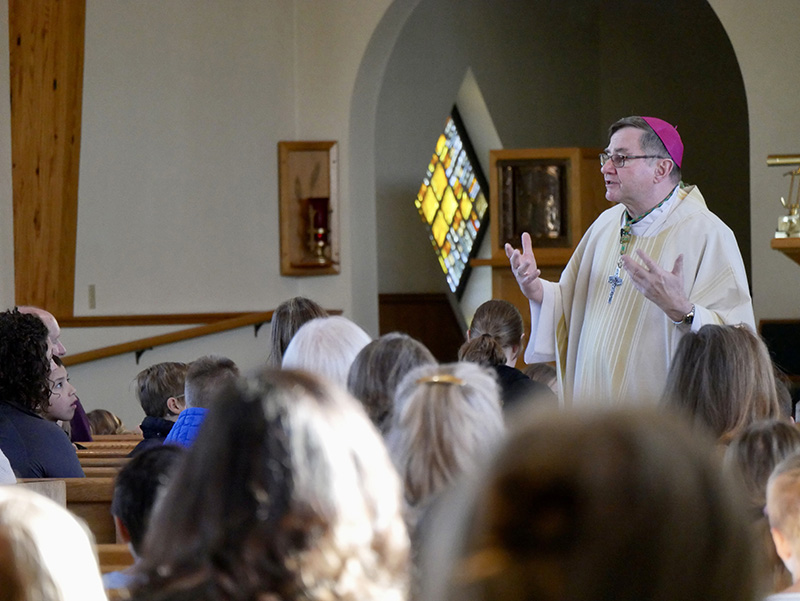
Bishop James P. Powers preaches the homily to students from St. Joseph’s School in Rice Lake, St. Francis Solanus Mission School in Reserve, Our Lady of Sorrows in Ladysmith and St. Francis de Sales School at their parish in Spooner on Friday, Feb. 2, to end Catholic Schools Week. (Submitted photo)
Jenny Snarski
Catholic Herald Staff
Bishop James P. Powers welcomed students to one of the four Bishop’s Masses held annually during Catholic Schools Week. On Friday, Feb. 2, a Mass was offered at St. Francis de Sales in Spooner with Catholic school students from Rice Lake, Ladysmith and Reserve also attending.
The Mass was concelebrated by Fr. Adam Laski and Fr. Isaiah Schick from Rice Lake, Fr. Karun from Hayward/Reserve and Fr. Phil Juza from Spooner, assisted by Spooner cluster Dcn. Pat Haines.
The bishop began his homily wishing those present a Merry Christmas. Responding to the confused looks on faces and turning heads, Bishop Powers asked students, “How many days do we celebrate Christmas?”
The answer “12” was given, and he clarified that, at one point in the church’s history, it was 40 days. Bishop Powers then asked what other significant events are also associated with the number 40. Answers included Noah and the flood, the days of Lent, days Jesus was in the desert and the 40 years the Israelites wandered in the desert.
He explained that the season of Christmas was formerly also 40 days in length to keep this connection. “When Jesus was born, we say that he was the light coming into the world,” he explained. He asked the children if they remembered how short the days were, and how dark, right around Christmas.
“It stays light longer now doesn’t it?” he asked and continued, “Understanding Jesus as the light of world, how important that light is … candles are also important parts of our lives.”
He asked again for participation on why candles are important and when we use them – to celebrate, to give light and aromas. He then pointed to the Easter candle near the baptismal font. “How important that candle is,” he said and shared that he still has his own baptismal candle.
The importance of the Easter candle, Bishop Powers said, is that it represents Jesus, “the light of Christ in our presence… All of these are things that flow from what we celebrate at Candlemas and the Presentation of Jesus.
“Jesus, the Son of God who came to save us, instead of coming as a mighty warrior king like they expected, come as a tiny little baby just like each and every one of us. Jesus is presented in the temple just as every male child was presented 1,000 years before his birth, and still today.”
“Jesus changes everything,” the bishop continued. “Because with Jesus, we’re no longer waiting for the Messiah – he is the Savior.”
This, he explained, is what Simeon and Anna had been praying and waiting for, for so many years. He then said how big the temple in Jerusalem was, bigger than the entire city block where St. Francis de Sales is located. He added that Simeon and Anna were likely not the only two waiting for Jesus who were in the temple that day.
“But they’re the only two we’re told about who recognized him,” he said. “Sadly, there are many times that we don’t recognize him either.”
Connecting with the baptisms of those present, Bishop Powers recognized the special occasion that is for gathering and drew a parallel with the special occasion of gathering for the Catholic Schools Week Mass.
“We come together to pray. How important that prayer is in helping us to grow as children of God,” he said. “How important that prayer is to grow in our ability to see that presence of Christ. By our baptism we’re all called to be Christ to one another,” and he explained how Christ has identified himself with every person, those baptized being part of his body.
“In Catholic schools, we have the opportunity to pray and speak of Christ’s presence,” Bishop Powers said.
He shared about the letters he receives from high school students as they are preparing for Confirmation and how so many of them express the experience of not appreciating the prayer they had in Catholic school until they were in public high school and didn’t have prayer as part of their school day anymore.
Interacting with students once more, the bishop brought up ways that we can be Christ to one another.
“There’s no end to what we can do, is there?” he encouraged and said how easy it can be to think that God is asking us to do “some huge thing“ to reflect Christ. He added that simply by doing those things “knowing that we’re doing them as a child of God, an image of Christ – what a difference in makes in us and in those we encounter.”
Speaking of the Eucharist, “that greatest gift,” the bishop concluded, “Jesus gives us himself to take him, that we might become more like him. Let us pray that we never let receiving him become habit … That we never, ever lose that appreciation, respect and adoration the body of Christ … Let us pray that we truly do reflect him in what we say and what we do.”
